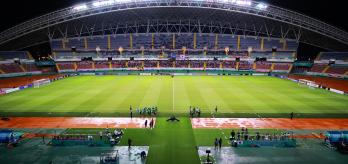Japan are the defending champions, having won the last instalment of the competition in France in 2018. On that occasion, they overcame Spain on a 3-1 score line, so this year's final presents an intriguing match-up between two sides with contrasting approaches to attacking play in possession, and aggressive pressing styles out of possession.
Our Technical Study Group has observed every match at this tournament and here they look ahead to what promises to be a fascinating encounter.
Spain
Spain topped Group A, scoring eight goals and conceding none before defeating Mexico 1-0 in their quarter-final. A 2-1 victory over the Netherlands in the semi-final was the first time the Spanish side conceded a goal in this competition, whilst centre-forward Inma Gabarro is the tournament's top-scorer to date, scoring seven of Spain's eleven goals.
Line-ups
Spain played with a back four throughout the group stages and in the quarter-final against Mexico, but changed their shape for their last-four encounter with the Netherlands.
The change in strategy was effective as Spain dominated possession in the semi-final and here Anja Mittag explains the Spanish approach.
In possession
In possession, Spain are a team that likes to build play; they have the quality and players to find different solutions to defensive challenges posed by opposition teams.
In-form centre-forward, Inma Gabarro has been a standout performer throughout the competition so far, scoring seven of Spain's eleven goals. When Spain build play, they have a particular affinity for delivering crosses to their centre-forward when in the final third.
While they can progress play in a number of ways, their ability to pick Gabarro out from crosses has been a key component in her goal-scoring capability, particularly because of her discipline in staying in the central channel and her impactful movement around the opposition centre-backs.
Spain rank second in the tournament for successful crosses per 90 minutes. But crucially, the successful crosses delivered to Gabarro really count. Of the ten delivered to her so far, nine have resulted in attempts at goal, with three of those attempts resulting in goals.
As a former centre-forward, Anja Mittag has really enjoyed observing the performances of Gabarro with her movement particularly impressing the former Germany international.
Out of possession
While there is no denying Spain's attacking prowess, they also boast the tightest defence of any team in the competition so far, conceding just one goal, and that in their 2-1 semi-final victory over the Netherlands.
Spain have demonstrated a willingness and hunger to press teams high, with an impressive degree of controlled aggression. Once initiated, their pressing strategy is often man-to-man and operates in a defined and co-ordinated way.
There are clearly allocated roles, and their players show a great desire to win the ball back and counter-attack. The two-player forward line of their defensive structure against Netherlands allowed the first pass from the opposition goalkeeper, before locking off both centre-backs, while also ensuring the defensive midfielder was closely marshalled.
Everywhere else across the pitch, players defend on the front foot, taking responsibility to ensure the ball does not progress via the opposing player in their domain. This strategy could be crucial when faced with a Japan team that wants to build through the thirds with a strong reliance on their defensive midfielder being able to get on the ball.
For Anja Mittag, Spain must get high pressure on the ball in order to negate Japan from progressing play and reaching the central channel approaching the final third.
Player to watch: (6) Ariadna Mingueza
Spain boast a squad of very talented players, with robust defenders and creative attackers. Twice in this tournament, their defensive midfielder Ariadna Mingueza was named player of the match by our Technical Study Group.
An intelligent reader of the game, she is very influential both in and out of possession. She marshals the territory in front of her centre-backs with great precision and awareness, intercepting and blocking attempted forward passes. Additionally, she is dynamic in getting forward from midfield, scoring a goal from the edge of the penalty area against Colombia.
Here, Anja Mittag explains the attributes she brings that could be impactful in the final against Japan.
Key strategic approach
Spain have a potent goalscorer in Inma Gabarro and it will be crucial for them to ensure they get her into the game as much possible against Japan. But Spain may also be required to defend more and for longer spells than they have had to do in previous games.
Mittag explains what she feels Spain need to do, in order to overcome Japan in Sunday's final.
Goalkeeper
In Txell Font, Spain have a young but very competent goalkeeper as the anchor of their team. The 17-year-old has been hugely impressive since she replaced the injured Adriana Nanclares in the 70th minute of their 3-0 group stage victory over Australia.
She kept a clean sheet in their quarter-final win over Mexico and is a goalkeeper who has impressed FIFA goalkeeping expert Pascal Zuberbühler.
Font has impressive variety and competence in her distribution demonstrating an ability to play through, around, into and onto.
Here Zuberbühler discusses her distribution as a key strength and an important component of Spain's capacity to build play.
Japan
Japan progressed to the quarter-finals as Group D winners. Their last-eigth clash with France was decided on penalties after a pulsating game that finished 3-3 after extra-time and then they overcame Brazil 2-1 in the semi-final to progress to Sunday's final, where they will aim to defend their U-20 Women's World Cup title.
Line-ups
Japan have been extremely consistent in their style of play in this tournament. Favouring a 5-3-2 system, they are an intricate passing team that wants to move the ball quickly, between and in behind opposition lines, at high tempo and at one-and-two touches.
Here, Mónica Vergara explains the principles of Japan playing style.
In possession
Japan enjoy problem-solving with the ball. In possession, their players constantly move to create passing angles with a particular focus on breaking the lines of the opponent's defence. They move the ball quickly, at one and two touch, using and creating triangulated passing patterns to tempt opposing defenders out of their shape and to disturb their team structure.
They want to attack through the central channel as they approach the final third of the pitch and use the clever and co-ordinated movements of their forward players to drag defenders into spaces they do not want to be. When the opponent's lines are disturbed, Japan have players with the intelligence to make runs in behind, and others who have the technique to execute the passes required to reach the runners ahead of the ball.
They are relentless in this way of playing. To defend against it requires a huge amount of concentration and discipline and also the capacity to maintain it for long spells in the game.
Mónica Vergara has been impressed with how Japan unleash and maintain this playing style when they have the ball.
The movement of Japan's forward players is integral to their success as a team to advance their attacking play and eliminate defenders from their opponent's structure.
(11) Maika Hamano and (9) Yuzuki Yamamoto are key players in this respect, consistently working in tandem to drop between units 2 and 3 to receive, and to make offers to receive in behind the opposition's defensive line. They always work in synergy, alternating the roles.
The effectiveness of this forward movement is detailed here by Vergara.
Out of possession
Out of possession, Japan have a disciplined, collective approach. Everything they do, they do as a team. If they press high, they go as a team; if they drop into a mid block, they do it together; if they squeeze the opposition onto one side of the pitch, the whole team remains connected until they win the ball back and become more expansive.
They communicate very effectively to maintain the optimal distances in their compactness and narrow shape, and they work very hard. Every player knows their role and they are fully committed to it.
Again, their structured and collective approach has impressed our TSG and here, Mónica Vergara explains why:
Player to watch: (6) Aemu Oyama
One of the most impressive aspects about Japan's approach is the culture of their team. There is great humility in their group with everyone having an equally important role to play in order to deliver the objectives of the team.
However, our TSG have recognised the qualities that centre-midfielder (6) Oyama brings to her role, from both an attacking and defensive perspective.
Our data shows that she executes more successful line breaks through the opponent's shape per 90 minutes than any other player in the tournament.
Vergara explains why Oyama's performances have been notable.
Key strategic approach
Japan have a distinct style of play but on Sunday, they must try to stop the tournament's top scorer, Inma Gabarro, and prevent Spain from finding her from crosses. They must also figure out a way of opening the tournament's meanest defence, as this Spanish team has only conceded one goal so far.
Vergara explains what Japan need to do to negate Spain's attack.
Goalkeeper
For Pascal Zuberbühler, Japan's Shu Ohba, has been a standout goalkeeper in this tournament. She is a brave, confident player but it is her ability and technique when coming to claim high balls that has really impressed our TSG.
Here Zuberbühler discusses her technique in coming for high balls and the mentality she demonstrates in key moments of the game.
Conclusion
Sunday's FIFA U-20 Women’s World Cup final between Spain and Japan promises to be a fascinating encounter between two teams that have demonstrated strong tactical awareness, and the capacity to execute game plans in a very controlled and cohesive manner. Both teams bring physicality and athleticism and have players who can change the game.
Two contrasting styles will clash and this will be a very tactical game. It will be enthralling and a final that will highlight the incredible multi-faceted growth in U-20 women’s football that has been evident during this tournament.









































